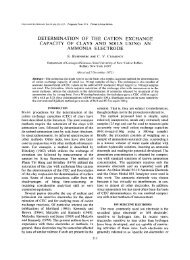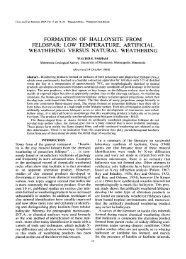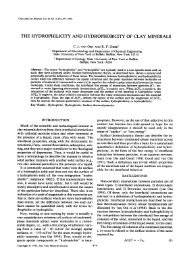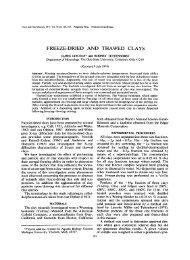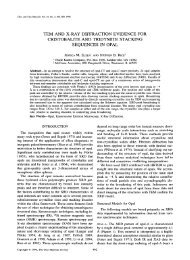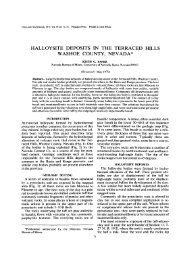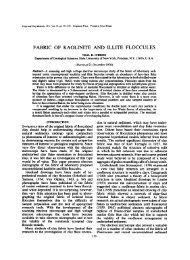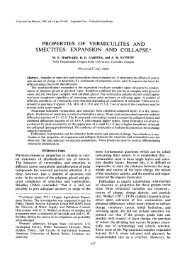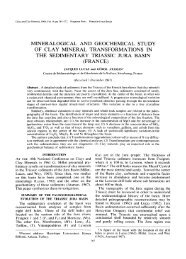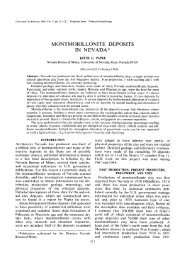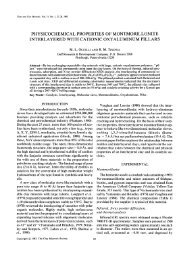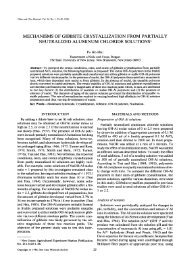halloysite-kaolinite transformation at room temperature
halloysite-kaolinite transformation at room temperature
halloysite-kaolinite transformation at room temperature
Create successful ePaper yourself
Turn your PDF publications into a flip-book with our unique Google optimized e-Paper software.
Clays a~td Clay Minerals, VoL 23. pp 109 113. Pergamon Press 1975. Printed in Gre<strong>at</strong> Britain<br />
HALLOYSITE-KAOLINITE TRANSFORMATION<br />
AT ROOM TEMPERATURE<br />
A. LA IGLESIA and E. GALAN<br />
Departamento de Cristalografia y Mineralogia, Facultad de Ciencias, Universidad Complutense de Madrid;<br />
and Secci6n de Mineralogia del Instituto 'Lucas MaUada', C.S.I,C. Madrid, Spain<br />
(Received 8 June 1974)<br />
Abstraet--Halloysite (meta<strong>halloysite</strong>) of various particle sizes has been altered with oxalic and EDTA<br />
acids, <strong>at</strong> <strong>room</strong> temper<strong>at</strong>ure and during different periods of time (5-90 days). The oxalic acid <strong>at</strong>tack<br />
<strong>at</strong> first achieved only a recrystalliz<strong>at</strong>ion of <strong>halloysite</strong>. The recrystalliz<strong>at</strong>ion is much more significant<br />
the smaller the size of the tre<strong>at</strong>ed <strong>halloysite</strong> particles. L<strong>at</strong>er the m<strong>at</strong>erial is destroyed. The EDTA<br />
tre<strong>at</strong>ment also has provoked during the first days a recrystalliz<strong>at</strong>ion of the halloysitic m<strong>at</strong>erial which<br />
is destroyed again after about 20-25 days. L<strong>at</strong>er <strong>kaolinite</strong> is formed. The kinetic curve of <strong>kaolinite</strong><br />
form<strong>at</strong>ion is symmetrical with respect to th<strong>at</strong> corresponding to the diminution of amorphous m<strong>at</strong>erial<br />
in the sample. The influence of the <strong>halloysite</strong> particle size and the complexing effect of the acids<br />
in rel<strong>at</strong>ion to the resulting products are discussed.<br />
INTRODU CTION<br />
The <strong>transform<strong>at</strong>ion</strong> of <strong>halloysite</strong> to <strong>kaolinite</strong> <strong>at</strong> <strong>room</strong><br />
temper<strong>at</strong>ure is theoretically possible, since <strong>halloysite</strong><br />
is metastable with respect to <strong>kaolinite</strong>. The free ener-<br />
gies of form<strong>at</strong>ion of these minerals (Hem et al., 1973)<br />
are, respectively:<br />
mG ~ H/> - 898-4 kcal/ml<br />
AG~ > K = -902.9 kcal/ml.<br />
The difference between them logically favors the<br />
<strong>transform<strong>at</strong>ion</strong> of haUoysite to <strong>kaolinite</strong>.<br />
In N<strong>at</strong>ure, such a <strong>transform<strong>at</strong>ion</strong> was proved by<br />
Tamura and Jackson (1953), who established th<strong>at</strong> in<br />
certain kaoliniferous soils formed from feldsp<strong>at</strong>hic<br />
rocks, there existed a successive sequence of <strong>transform<strong>at</strong>ion</strong>s<br />
from feldspar to <strong>kaolinite</strong>, passing through<br />
amorphous stages (allophanes), hydr<strong>at</strong>ed <strong>halloysite</strong><br />
and meta<strong>halloysite</strong>. Subsequently, Kinoshita and<br />
Muchi (1954), Fieldes (1955), Sudo and Takahashi<br />
(1956), Ponder and Keller (1960), Keller (I964) and<br />
Chen (1969) among others, upon studying different<br />
processes of kaoliniz<strong>at</strong>ion, have found <strong>transform<strong>at</strong>ion</strong>s<br />
of <strong>halloysite</strong> to <strong>kaolinite</strong>, especially under<br />
we<strong>at</strong>hering conditions.<br />
These <strong>transform<strong>at</strong>ion</strong>s have been observed also in<br />
some Spanish kaolin deposits by Galan and Martin<br />
Pozas (1971), Martin Pozas et al. (1971), Galan (1972)<br />
and Galan and Martin Vivaldi (1973), appearing in<br />
some of these deposits sequences more or less complete<br />
from K-feldspar, or Na-plagioclases, to ordered<br />
<strong>kaolinite</strong>s, through aluminium oxides, allophanes,<br />
hydr<strong>at</strong>ed <strong>halloysite</strong>, meta<strong>halloysite</strong> and disordered<br />
<strong>kaolinite</strong>.<br />
The experimental <strong>transform<strong>at</strong>ion</strong> of <strong>halloysite</strong> to<br />
<strong>kaolinite</strong> <strong>at</strong> <strong>room</strong> temper<strong>at</strong>ure has not been undertaken<br />
until now. In this paper, we present the results<br />
of the alter<strong>at</strong>ion <strong>at</strong> <strong>room</strong> temper<strong>at</strong>ure of <strong>halloysite</strong><br />
109<br />
with oxalic and ethylenediamine tetra-acetic acids in<br />
which processes <strong>kaolinite</strong> has been obtained.<br />
MATERIAL AND METHODS<br />
The alter<strong>at</strong>ion with oxalic acids and EDTA has<br />
been carried out over Eureka <strong>halloysite</strong> (API, No.<br />
16) th<strong>at</strong> is essentially composed of meta<strong>halloysite</strong>,<br />
with illite and quartz as impurities.<br />
The <strong>halloysite</strong> has been subjected previously to a<br />
prolonged dry grinding in a Glen Creston mixer mill<br />
with a polyestyrene cylindrical vial with covers of<br />
wolfram carbide and balls of the same m<strong>at</strong>erial, for<br />
the purpose of obtaining small-sized particles, which<br />
have been controlled by X-ray diffraction according<br />
to the methods of Scherrer (in Klug and Alexander,<br />
1954), and using the 02 band (4.43 A),<br />
K<br />
In the equ<strong>at</strong>ion: D0k -- B Cos 0<br />
K is the so-called 'form factor' and according to Klug<br />
and Alexander (1954) its value is 1.84 for a Ok band<br />
according to Brindley and Robinson (1948), 2 is<br />
1.54 A (Cuk c~-radi<strong>at</strong>ion) and B is the half-maximum<br />
line breadth.<br />
To the value calcul<strong>at</strong>ed directly for B it is necessary<br />
to subtract the width of the peak which, for the angle<br />
considered, involves the diffractometer used. This<br />
value has been calcul<strong>at</strong>ed using well-crystallized<br />
quartz (2-20#m size), measuring the width of the<br />
reflections <strong>at</strong> 4.26, 3.34 and 1"82 A and deducing from<br />
them those corresponding to the 4.42 reflection, calcu-<br />
l<strong>at</strong>ed by extrapol<strong>at</strong>ion.<br />
The distribution of the <strong>halloysite</strong> particle size as<br />
a function of the grinding time is shown in Table<br />
1. Nevertheless, such calcul<strong>at</strong>ed values are less than<br />
the real ones, since for their determin<strong>at</strong>ion we have<br />
used the reflection <strong>at</strong> 4-43 A, which presents a band
110 A. LA IGLESIA and E. GALAN<br />
442<br />
/~ 7.,o /<br />
4'43<br />
40 30 20 I 0<br />
28C u Ko<br />
Fig. 1. X-ray diffraction p<strong>at</strong>terns of n<strong>at</strong>ural <strong>halloysite</strong> (frac-<br />
tion A), and <strong>halloysite</strong> ground for 1, 2.5 and 5 hr (B, C<br />
and D fractions, respectively).<br />
form. This band is the only <strong>halloysite</strong> reflection<br />
observed after the successive grindings (Fig. 1), and<br />
for this reason it has been impossible to choose<br />
another.<br />
In Figs. 2-4, by means of the electron microscope,<br />
the successive destruction of the <strong>halloysite</strong> crystals<br />
during the grinding is observed.<br />
The alter<strong>at</strong>ion of the <strong>halloysite</strong> has been realized<br />
under <strong>room</strong> conditions, tre<strong>at</strong>ing 0.2 g of <strong>halloysite</strong><br />
with 0.2 g of acid in 4 rnl of w<strong>at</strong>er (molar rel<strong>at</strong>ion<br />
A1/EDTA = 2.27 and A1/oxalic = 0.70) during time<br />
periods from 5 to 90 days for each one of the acids<br />
and different particle sizes mentioned beforehand.<br />
The n<strong>at</strong>ure of the products resulting from the alter-<br />
<strong>at</strong>ion of the <strong>halloysite</strong> has been studied by X-ray<br />
diffraction (powder method) and the morphologic<br />
changes have been followed by electron microscopy.<br />
For the X-ray diffraction evalu<strong>at</strong>ion of the quantity<br />
of amorphous m<strong>at</strong>erial formed during the grinding<br />
of the <strong>halloysite</strong>, and for the percentage calcul<strong>at</strong>ion<br />
of neoformed <strong>kaolinite</strong> (in the resulting products of<br />
the alter<strong>at</strong>ion), potassium chloride <strong>at</strong> 50 per cent has<br />
been used as an internal standard. Previously,<br />
calibr<strong>at</strong>ion curves were made from binary mixtures<br />
of potassium chloride with Eureka <strong>halloysite</strong> and<br />
Ot<br />
40 --480<br />
3OO<br />
1100<br />
9 , 200 -- 40<br />
9 I<br />
25 5<br />
Grinding time, hrs<br />
Fig. 5. Diminution of the <strong>halloysite</strong> particle size and for-<br />
m<strong>at</strong>ion of amorphous m<strong>at</strong>erial in function of grinding time.<br />
standard <strong>kaolinite</strong> (API No. 1) using the reflections<br />
3.15 ,~ of potassium chloride, 4.43 and 3-60 ~, of hal-<br />
loysite, and 7-15 and 3.57A of <strong>kaolinite</strong>.<br />
In Fig. 5, the diminution of the haUoysite particle<br />
size is shown, together with the simultaneous growth<br />
of amorphous m<strong>at</strong>erial, as a function of the grinding<br />
time.<br />
Alter<strong>at</strong>ion with oxalic acid<br />
RESULTS<br />
All the different sizes of the <strong>halloysite</strong> particle<br />
altered with oxalic acid have undergone a recrystalli-<br />
z<strong>at</strong>ion th<strong>at</strong> culmin<strong>at</strong>es around 20--30 days of tre<strong>at</strong>-<br />
ment; after which time it gradually shrinks or returns<br />
to the initial percentage, in agreement with the in-<br />
crease of time of <strong>halloysite</strong>--oxalic contact. The recrys-<br />
talliz<strong>at</strong>ion is more significant the smaller the size of<br />
the tre<strong>at</strong>ed <strong>halloysite</strong> particles.<br />
Alter<strong>at</strong>ion with EDTA<br />
N<strong>at</strong>ural <strong>halloysite</strong> (<strong>halloysite</strong> A). During the first<br />
days of acid tre<strong>at</strong>ment, a sudden destruction of the<br />
<strong>halloysite</strong> is observed (Fig. 6). After 5 days the des-<br />
truction continues, although with a much slower reac-<br />
tion speed. At the end of 60 days of tre<strong>at</strong>ment, no<br />
new crystalline m<strong>at</strong>erials have appeared. The n<strong>at</strong>ural<br />
<strong>halloysite</strong> tre<strong>at</strong>ed with EDTA has not modified appre-<br />
ciably its morphology (Fig. 7), except for the presence<br />
of some coarser tubes, approx. 4 or 5 times larger<br />
than the original ones, th<strong>at</strong> appear to be the result<br />
of a recrystalliz<strong>at</strong>ion.<br />
Halloysite ground Jbr I hr (<strong>halloysite</strong> B). This frac-<br />
tion recrystallizes during the first 20 days (Fig. 6),<br />
self-destructing continuously. After about 50 days, the<br />
curve stabilizes itself. Simultaneously, and about day<br />
40, the presence of <strong>kaolinite</strong> begins to be observed.<br />
Through the electron microscope, large newly-<br />
formed tubes and fl<strong>at</strong> particles are observed (Fig.<br />
8).<br />
Halloysite 9roundfor 2'5 hr (<strong>halloysite</strong> C). The star-<br />
ting m<strong>at</strong>erial undergoes an initial recrystalliz<strong>at</strong>ion (un-<br />
100,<br />
o = % Halloysite (A)<br />
9 = % Halloysite (B)<br />
_ =~ite (B)<br />
80<br />
60<br />
40--<br />
20--<br />
10 20 30 40 50 60<br />
Time, deys<br />
Fig. 6. Tre<strong>at</strong>ment of the A and B <strong>halloysite</strong> fractions with<br />
EDTA.
JO0/~<br />
|<br />
o=%Halloysite (C)<br />
a = %Kaolinite (C)<br />
80 F -- 9 = %Amorphous(C)<br />
1<br />
2~ ~'--~"<br />
Transform<strong>at</strong>ion of <strong>halloysite</strong> and <strong>kaolinite</strong> 111<br />
V I I I I I I<br />
io 20 30 40 50 60<br />
Time, days<br />
Fig. 9. Tre<strong>at</strong>ment of <strong>halloysite</strong> C with EDTA.<br />
til day 10 of tre<strong>at</strong>ment). The percentage of <strong>halloysite</strong><br />
then remains practically constant throughout the l<strong>at</strong>er<br />
tre<strong>at</strong>ment. The percentage of amorphous m<strong>at</strong>erial,<br />
th<strong>at</strong> drops sharply in the first 10 days (Fig. 9), stabi-<br />
lizes itself in the 10--20-day interval, and drops once<br />
again towards day 50 in which equilibrium is reached.<br />
At the same time, and from the first few days,<br />
the appearance of <strong>kaolinite</strong> begins to be observed,<br />
and the kinetic curve of form<strong>at</strong>ion is symmetric with<br />
respect to th<strong>at</strong> of the diminishing amorphous m<strong>at</strong>er-<br />
ial. It must be specified th<strong>at</strong> the two intervals of<br />
<strong>kaolinite</strong> growth coincide <strong>at</strong> th<strong>at</strong> time with the two<br />
intervals of diminution of the percentage of amor-<br />
phous m<strong>at</strong>erial, which indic<strong>at</strong>es an interdependence<br />
between the diminution of the l<strong>at</strong>ter and the forma-<br />
tion of the <strong>kaolinite</strong>.<br />
With the electron microscope, after 30 days of<br />
tre<strong>at</strong>ment, the presence of subrounded, fi<strong>at</strong> and angu-<br />
lar crystals is clearly observed. The tubular forms<br />
characteristic of <strong>halloysite</strong> hardly appear (Fig. 10).<br />
Halloysite ground Jbr 5 hr (<strong>halloysite</strong> D). The beha-<br />
viour of <strong>halloysite</strong> D during the alter<strong>at</strong>ion is similar<br />
to th<strong>at</strong> of fraction C (Fig. 11). The percentage of<br />
amorphous m<strong>at</strong>erial decreases while th<strong>at</strong> of <strong>kaolinite</strong><br />
increases symmetrically with the previous curve.<br />
During the first few days, a recrystalliz<strong>at</strong>ion of hal-<br />
loysite occurs, th<strong>at</strong> morphologically shows itself as<br />
coarse tubes of variable length. On day 35, small-sized<br />
particles of <strong>kaolinite</strong>s appear, coexisting with tubular<br />
<strong>halloysite</strong>s and amorphous m<strong>at</strong>erial (Fig. 12).<br />
By day 90, the halloysitic m<strong>at</strong>erial has practically<br />
I00<br />
80<br />
~- 60<br />
o<br />
,~ 40<br />
20<br />
_ o = % Holloysite (D)<br />
A=% Kaolinite (O)<br />
9 =% Amorphous(D)<br />
I 1 I I<br />
5 15 25 35 45 55<br />
Time, days<br />
Fig. 11. Tre<strong>at</strong>ment of haUoysite D with EDTA.<br />
disappeared (Fig. 13) and small-sized crystals of kao-<br />
linite show up (0.1-0.2pro), sometimes subrounded<br />
and <strong>at</strong> other times of a good hexagonal morphology,<br />
together with amorphous m<strong>at</strong>erial (Fig. 14).<br />
DISCUSSION<br />
Influence of the organic acids<br />
The mechanism of the reaction has probably con-<br />
sisted of an <strong>at</strong>tack by the acid on the 'amorphous'<br />
as welt as crystallized <strong>halloysite</strong>, complexing alu-<br />
minum and leaving silica in dissolution. The AI-<br />
organic acid complex formed, dissoci<strong>at</strong>es to the extent<br />
permitted by its constant of dissoci<strong>at</strong>ion. In this par-<br />
ticular case, the silica influences the concentr<strong>at</strong>ion<br />
of aluminum in dissolution by the possibility of form-<br />
ing condensed phases of Si-O-AI type.<br />
It is possible th<strong>at</strong> the conditions of precipit<strong>at</strong>ion<br />
in homogenous solution for the synthesis of clay<br />
minerals <strong>at</strong> low temper<strong>at</strong>ure are those postul<strong>at</strong>ed by<br />
La Iglesia and Martin Vivaldi (1974). The Al-organic<br />
acid complex has served as a source of aluminum<br />
liber<strong>at</strong>ing it <strong>at</strong> a velocity suitable for the crystal<br />
growth r<strong>at</strong>e. If the dissoci<strong>at</strong>ion constant of the A1-<br />
organic acid compound is low, the liber<strong>at</strong>ion velocity<br />
of A13+ will be high and therefore the product of<br />
the microconcentr<strong>at</strong>ion of SiOz with th<strong>at</strong> of A13 +,<br />
in wh<strong>at</strong>ever point of the system, will exceed to the<br />
solubility product of the <strong>kaolinite</strong> or <strong>halloysite</strong> and<br />
will produce a silica-alumina gel, since a large quan-<br />
K<br />
:5'54 K 7'07<br />
K<br />
K I 4.48 I<br />
K K<br />
2.58<br />
K<br />
~:~ H<br />
~o 3-61 11 ,<br />
28 Cu K~,<br />
Fig. 13. X-ray diffraction p<strong>at</strong>tern of <strong>halloysite</strong> D tre<strong>at</strong>ed with EDTA during 90 days.<br />
0
112 A. LA IGLESIA and E, GALAN<br />
tity of crystalline nuclei appear, and the dissolution<br />
becomes poorer in aluminum and silica. Probably<br />
this is the process occurring in the alter<strong>at</strong>ion with<br />
oxalic acid. Under these conditions, the difference<br />
between the free energy of form<strong>at</strong>ion of <strong>kaolinite</strong> and<br />
<strong>halloysite</strong> is in favor of a partial crystalliz<strong>at</strong>ion of<br />
<strong>halloysite</strong>.<br />
On the contrary, the EDTA-A1 complex with a<br />
larger dissoci<strong>at</strong>ion constant starts a lower A13 + mic-<br />
roconcentr<strong>at</strong>ion, which permits the crystalliz<strong>at</strong>ion of<br />
<strong>kaolinite</strong> in these experimental conditions.<br />
The speed of <strong>at</strong>tack of the halloysitic m<strong>at</strong>erial<br />
depends on the pK of every acid considered. The<br />
oxalic acid has a pK of 1.19 while the EDTA has<br />
a pK of 2.02, for which one can expect a much more<br />
intense <strong>at</strong>tack than the first, besides bearing in mind<br />
th<strong>at</strong> the oxalic acid is much more soluble than the<br />
EDTA. Both factors condition a rapid form<strong>at</strong>ion of<br />
the M-oxalic complex th<strong>at</strong> would give, as a final<br />
consequence, an increase of the microconcentr<strong>at</strong>ion<br />
of A13+ and a tendency towards the form<strong>at</strong>ion of<br />
an amorphous silico--aluminic phase.<br />
Experiments similar to these have been carried out<br />
by Dennfeld et al. (1970), erystalliz<strong>at</strong>ing <strong>kaolinite</strong> <strong>at</strong><br />
hydrothermal temper<strong>at</strong>ure, starting with ground gibb-<br />
site and amorphous silica, and using various organic<br />
acids as c<strong>at</strong>alyzers. These authors conclude th<strong>at</strong> the<br />
Al-organic acid complex with a smaller dissoci<strong>at</strong>ion<br />
constant are those which favor the crystalliz<strong>at</strong>ion of<br />
<strong>kaolinite</strong>. The disagreement with the present results<br />
can be due to the stability vari<strong>at</strong>ion of the compounds<br />
in the temper<strong>at</strong>ure function and to th<strong>at</strong> of the pK<br />
of the acids (hydrothermal conditions for Dennfeld<br />
and <strong>room</strong> conditions in our experiments). Kittrick<br />
(1970), on obtaining <strong>kaolinite</strong> <strong>at</strong> <strong>room</strong> temper<strong>at</strong>ure<br />
starting with montmorillonite in an equilibrium solu-<br />
tion for 3-4 years, with acid dissolutions, demon-<br />
str<strong>at</strong>es th<strong>at</strong> only the dissolutions with concentr<strong>at</strong>ions<br />
of SiO2 and A13 + supers<strong>at</strong>ur<strong>at</strong>ed with respect to the<br />
<strong>kaolinite</strong>, crystallize as <strong>kaolinite</strong>. In the present case,<br />
this supers<strong>at</strong>ur<strong>at</strong>ion is guaranteed in all the samples<br />
of ground <strong>halloysite</strong>.<br />
Influence of particle size<br />
The <strong>at</strong>tack on a solid phase depends on its exposed<br />
area. Therefore, the finer the sample is, the gre<strong>at</strong>er<br />
the <strong>at</strong>tack velocity will be. On the other hand, in<br />
the grinding, small 'amorphous' crystals rich in active<br />
places are obtained and these serve as nucleant agents<br />
in the crystalliz<strong>at</strong>ion. The recrystalliz<strong>at</strong>ion of the hal-<br />
loysite in the first days of tre<strong>at</strong>ment can be explained<br />
in this manner (see Figs. 6, 7, 10 and 12). This action<br />
confirms precisely th<strong>at</strong> the A <strong>halloysite</strong> (Fig. 7), an<br />
unground sample, does not recrystallize and also dis-<br />
solves itself.<br />
amorphous phases ~ <strong>halloysite</strong><br />
feldspar s,,~ ",~<br />
<strong>kaolinite</strong> ordered<br />
<strong>kaolinite</strong><br />
step 1 step 2<br />
In the process of alter<strong>at</strong>ion with EDTA it has been<br />
proved th<strong>at</strong> the fraction which produces the most<br />
<strong>kaolinite</strong> is C and not the fraction with the smallest<br />
size (D fraction), as it would be expected. This poss-<br />
ible anomaly can be explained because fraction D<br />
dissolves itself rapidly, obtaining a supers<strong>at</strong>ur<strong>at</strong>ion<br />
with respect to the <strong>kaolinite</strong> and precipit<strong>at</strong>ing amor-<br />
phous phases.<br />
In the case of fraction B, the solubility of the hal-<br />
loysite and the crystalliz<strong>at</strong>ion r<strong>at</strong>e of the <strong>kaolinite</strong><br />
are so small th<strong>at</strong> their growth is not appreciable<br />
before day 30.<br />
GEOLOGICAL INTERPRETATION<br />
In the <strong>transform<strong>at</strong>ion</strong> sequences observed or sug-<br />
gested by the different authors cited in the introduc-<br />
tion, the meta<strong>halloysite</strong>-ordered <strong>kaolinite</strong> step is<br />
effectu<strong>at</strong>ed through disordered <strong>kaolinite</strong>, by means<br />
of an intense we<strong>at</strong>hering action, and enlarging the<br />
mid-size crystals formed.<br />
In these experiments well-formed <strong>kaolinite</strong> has been<br />
obtained, although small in size and of irregular mor-<br />
phology. The <strong>halloysite</strong>--ordered <strong>kaolinite</strong> step does<br />
not necessarily proceed through disordered <strong>kaolinite</strong>.<br />
Halloysite can become amorphous and will liber<strong>at</strong>e<br />
aluminum under intense we<strong>at</strong>hering action. This alu-<br />
minum may or may not be complexed according to<br />
characteristics of the complexing substances. If AI 3+<br />
is complexed earlier, under the influence of silica in<br />
solution, <strong>kaolinite</strong> will be crystallized. In n<strong>at</strong>ure, the<br />
<strong>halloysite</strong>-ordered <strong>kaolinite</strong> <strong>transform<strong>at</strong>ion</strong> will take<br />
place when it is subjected to an intense we<strong>at</strong>hering<br />
action in the presence of M-complexes and with par-<br />
tial washing of the silica. The sequence will be:<br />
<strong>halloysite</strong>--* amorphous phase ~ ordered <strong>kaolinite</strong>.<br />
If the aluminum is not complexed, it will form an<br />
amorphous phase <strong>at</strong> other levels and in the presence<br />
of silica. This amorphous phase can be transformed<br />
into <strong>halloysite</strong> or <strong>kaolinite</strong> by an ageing process. This<br />
last <strong>transform<strong>at</strong>ion</strong> is increased if a new washing of<br />
silica occurs, and then gibbsite can be formed also.<br />
Feldspars can be transformed into <strong>kaolinite</strong> or into<br />
amorphous silico-aluminic phases, by hydrolysis (step<br />
1), depending on the we<strong>at</strong>hering conditions. The<br />
amorphous phase can become <strong>kaolinite</strong> or <strong>halloysite</strong><br />
(step 2), according to its crystalline predisposition and<br />
nucle<strong>at</strong>ion influence.<br />
In the last case, by ageing (step 3) the structure<br />
can be reordered, first to disordered and then to<br />
ordered <strong>kaolinite</strong>; by an intense washing it can<br />
become amorphous and if the conditions of step 2<br />
are repe<strong>at</strong>ed, ordered <strong>kaolinite</strong> will be formed.<br />
The various sequences suggested can be summar-<br />
ized graphically as follows:<br />
, disordered ~ ordered<br />
<strong>kaolinite</strong> <strong>kaolinite</strong><br />
step 3
The type of <strong>kaolinite</strong> synthesized is similar to th<strong>at</strong><br />
of flint clay type kaolins. Therefore in the genetic<br />
processes of flint clay kaolins (normally rel<strong>at</strong>ed to<br />
the levels of organic m<strong>at</strong>ter) similar conditions to<br />
those of these experiments, although with different<br />
complexes, may have occurred.<br />
REFERENCES<br />
Brindley, G. W. and Robinson, K. (1948) Structure of meta<br />
<strong>halloysite</strong>: Miner. Mag. 28, 393-406.<br />
Chen, P. Y. (1969) Occurrence and genesis of kaolin<br />
minerals from Taiwan (I), Kaolinite, <strong>halloysite</strong> and allo-<br />
phane: Proc. Geol. Soc. China 12, 30-48.<br />
Dennfeld, F., Siffert, B. and Wey, R. (1970) Etude de Fin-<br />
fluence des complexants de raluminium et du broyage<br />
des hydroxides d'aluminum sur la form<strong>at</strong>ion hydrother-<br />
male de la <strong>kaolinite</strong>: Bull. Groupe Franc. Argiles XXII,<br />
179-190.<br />
Fieldes, M. (1955) Clay mineralogy of New Zealand soils<br />
II: Allophane and rel<strong>at</strong>ed mineral colloids: N.Z.J.<br />
Sci. Technot. 37, 336-350.<br />
Galan, E. and Martin Pozas, J. M. (1971) Mineralogia<br />
de los caolines de La Guardia y E1 Rosal (Pontevedra,<br />
Espafia): Est. Geol. 27, 75-80.<br />
Galan, E. (1972) Caolines espafioles. Geologia, mineralogia<br />
y genesis. Thesis, Sciences Faculty, University of Madrid,<br />
Spain.<br />
Galan, E. and Martin Vivaldi, J. L. (1973) Caolines<br />
espafioles. Geologia, mineralogia y genesis--llI: Clasifi-<br />
cacidn de los depositos de caolines espafioles segun<br />
su ambiente genetico: Bol. Soc. Esp. Ceram. y Vidrio.<br />
12 (6), 333~340.<br />
Transform<strong>at</strong>ion of <strong>halloysite</strong> and <strong>kaolinite</strong> 113<br />
Hem, J, D., Roberson, C. E., Lind, C. J. and Polzer, W.<br />
L. (1973) Chemical interactions of aluminum with<br />
aqueous silica <strong>at</strong> 25~ Geol. Survey W<strong>at</strong>er-supply Paper,<br />
1827-E, p. 57.<br />
Keller, W. D. (1964) Processes of origin and alter<strong>at</strong>ion of<br />
clay minerals. Soil Clay Mineralogy (Edited by Rich and<br />
Kunze), pp. 3-75. The University of North Carolina<br />
Press, Durham, North Carolina.<br />
Kinoshita, K. and Muchi, M. (1954) Bauxitic clay derived<br />
from volcanic ash: Kyushukozan-gakkai 22, 279-291.<br />
Klug, H. P. and Alexander, L. E. (1954) X-Ray Diffraction<br />
Procedures for Polycrystalline and Amorphous M<strong>at</strong>erials.<br />
Wiley, New York.<br />
La Iglesia, A. and Martin Vivaldi, J. L. (1974) Synthesis<br />
of <strong>kaolinite</strong> by homogeneous precipit<strong>at</strong>ion <strong>at</strong> <strong>room</strong> tem-<br />
per<strong>at</strong>ure (I). Against anionic resins in (OH) form: 2nd<br />
Meeting of the European Clay Groups, Strasbourg. In<br />
press.<br />
Martin Pozas, J. M., Galan, E. and Martin Vivaldi, J.<br />
L. (1971) I1 giacimento di caolino di Jove (Lugo,<br />
Espafia): Atti. 1 ~ Congresso Naz. Grup. ltal. AIPEA,<br />
89-109.<br />
Ponder, A. and Keller, W. D. (1960) Geology, mineralogy<br />
and genesis of selected fire-clays from L<strong>at</strong>ah Country,<br />
Idaho, pp. 44--63: Clays and Clay Min. 8th Conf. Perga-<br />
mon Press, Oxford.<br />
Sudo, T. and Takahashi, H. (1956) Shapes of <strong>halloysite</strong><br />
particles in Japanese clays, pp. 67-79. Clays and Clay<br />
Min. 4th Co~!]i N<strong>at</strong>. Acad. Sci. 456, Washington.<br />
Tamura, T. and Jackson, M. L. (1953) Structural and<br />
energy rel<strong>at</strong>ionships in the form<strong>at</strong>ion of iron and alu-<br />
minium oxides, hydroxides and silic<strong>at</strong>es: Science 117,<br />
381-383.



